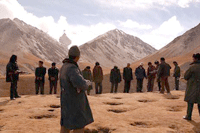In an early episode in Kekexili: Mountain Patrol, retired army officer turned volunteer poacher tracking commander Ritai (Duobuji) explains to a Beijing reporter Ga Yu (Zhang Lei) that according to custom, a Tibetan native would point his knife inward when cutting his meal at the dinner table. It is a seemingly anecdotal comment on cultural particularity that also serves as a broader metaphor for the environmental and social climate of the Kekexili during the mid 1990s, a stretch of uninhabited land dubbed the last virgin wilderness in China, as natives increasingly redirected their meager livelihood towards the dangerous and ecologically destructive, yet more lucrative trade of poaching Tibetan antelopes to meet international demand for their woolen pelts. With the antelope population quickly plummeting from a million to nearly 10, 000 within the span of a few short years, and unable to enlist the aid of the government into declaring Kekexili a wildlife refuge (and therefore, deploying troops to secure the area) in order to protect the endangered animals, Ritai has assembled his own army of volunteers to patrol the mountain region in an attempt to intercede the trafficking of pelts, often leading to violent – and sometimes fatal – skirmishes with the ruthless, well-armed poachers. Embarking on long expeditions away from family, friends, and colleagues, each parting is tainted with the impassioned, bittersweet realization of tragic inevitability. Based on the Ga Yu’s real-life chronicle of the volunteer militia’s final expedition to track down a band of poachers responsible for the murder (and publicly symbolic humiliation) of a colleague, the film is an understated, yet tightly constructed and compelling portrait of moral imperative, sacrifice, and everyday heroism. Recalling the austerity and geographic isolation of Tian Zhuangzhuang’s The Horse Thief, Lu Chuan similarly evokes a metaphoric image of alienation and spiritual desolation through panoramic shots of the majestic and unforgiving landscape (most notably, in the recurring shots of antelope carcasses and laid out animal pelts that reinforce the criticality of an unfettered mass extinction). It is in these curious images of despiritualized landscape that the film can be seen, not only through the filter of ecological responsibility, but also as a cautionary tale for the extinction of cultural identity within the unbridled frontier of globalism.
© Acquarello 2006. All rights reserved.
